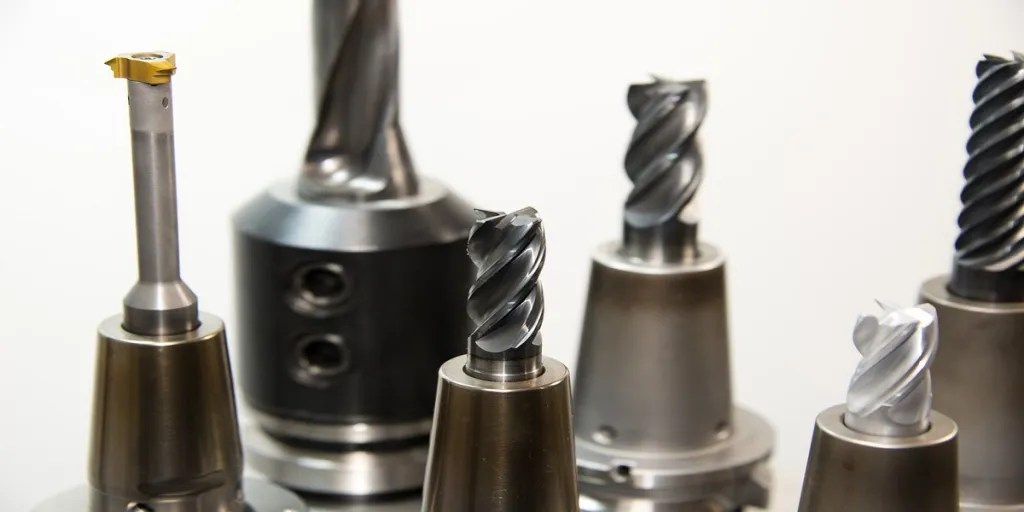There’s something irresistibly feminine about well-manicured nails. These days, it’s not just about sporting colorful, decorated fingertips; it’s about expressing personality, completing a cosmetic appearance, and showing off elegance.
But while wearing eye-catching gel or acrylic nails is an aesthetic bonus, many consumers don’t enjoy frequent trips to the nail salon. Thankfully, these consumers can get excellent nail jobs from home with an electronic nail file.
And with an electronic file comes the need for nail drill bits. Explore this buying guide to discover everything about nail drill bits and the different types in 2023.
Table of Contents
What are nail drill bits?
Three things to consider when choosing nail drill bits
All the types of nail drill bits available in the market
Wrapping up
What are nail drill bits?
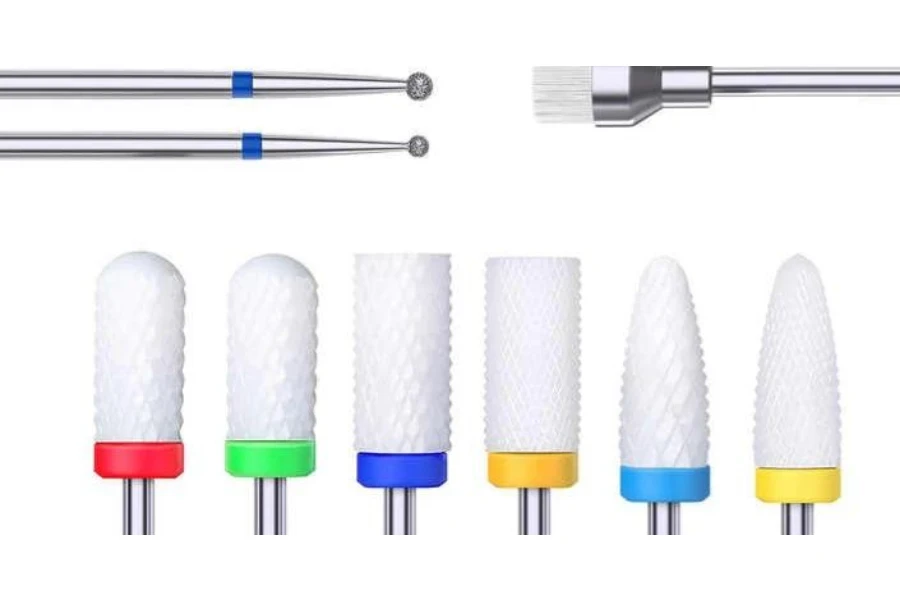
Nail drill bits are versatile attachments consumers can easily screw into an electronic nail file. They come in different materials, shapes, and sizes, allowing consumers to get the ones used in professional salons for home nail care routines.
Women can use nail drill bits to:
– Remove acrylic or gel polish
– Exfoliate cuticles
– Smoothen gel and acrylic nails
– File nails
– Prepare nails for enhancement
– Clean nail beds and areas under the nail
Three things to consider when choosing nail drill bits
Shank size
The shank size is the first to check when choosing a nail drill bit. Nail drill bits usually come in two sizes: 3/32 or ⅛ inch. Be sure to indicate the size of the preferred bits so consumers know they are getting ones that match their nail drill’s shank size.
Remember that a 3/32 inch bit will only fit a 3/32 inch nail drill shank, while a ⅛ inch bit will work with a ⅛ inch shank—no compromises.
Drill bit textures and grits
The texture and grit of a drill bit determine how aggressive it is and what tasks it’s best for. Regarding grit, it handles roughness or the smoothness of the nail’s abrasive surface. Grit ratings typically range from 80 to 1200, with lower numbers being coarser and higher numbers being finer.
Check out the breakdown of the different grits and how consumers can use them:
– Coarse grit (80-150): These bits are ideal for acrylic or gel extension removal, thick nail shaping, and quick length reduction.
– Medium grit (180-240): Medium grit bits are highly versatile, allowing users to shape natural nails, clear product buildup, and smoothen the nail’s surface.
– Fine grit (360-600): Fine bits are perfect for smoothing and buffing natural nails and are handy for removing ridges and imperfections.
– Extra fine grit (800-1200): Ultra-fine bits are excellent for buffing and making the nail surface glossy.
Color code
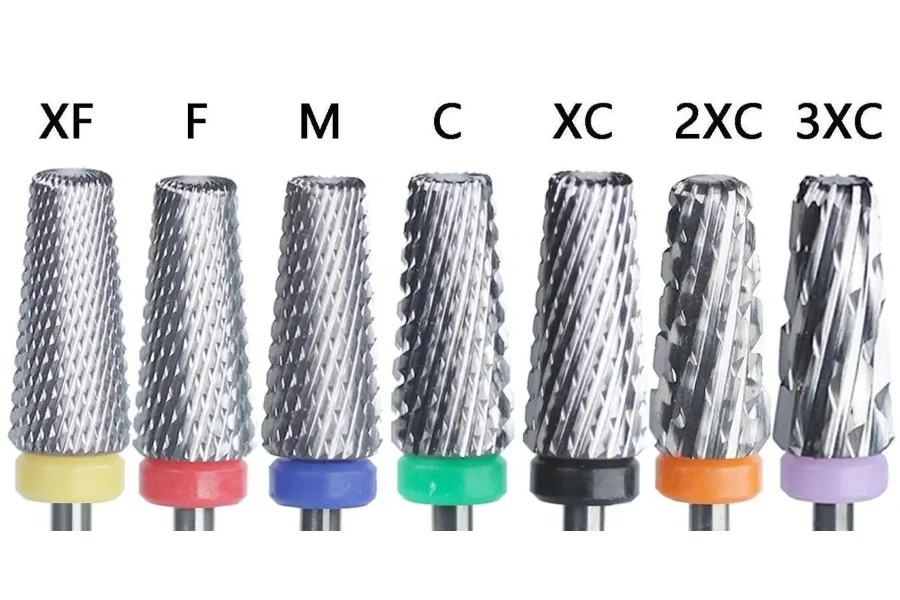
Color codes are a quick way to spot nail drill bit grit. It’s an excellent way for consumers to tell the difference between fine and extra coarse grits without the hassle of inspecting more minor details.
The color code divides nail drill bits into five categories that businesses can find in the table below:
| Color code | Coarseness |
| Black | Extra coarse |
| Green | Coarse |
| Blue | Medium |
| Red | Fine |
| Yellow | Superfine |
Some brands add two extra color codes to their offerings: Orange (2X coarse) and purple (3X coarse).
All the types of nail drill bits available in the market
Mandrel e-file nail drill bits
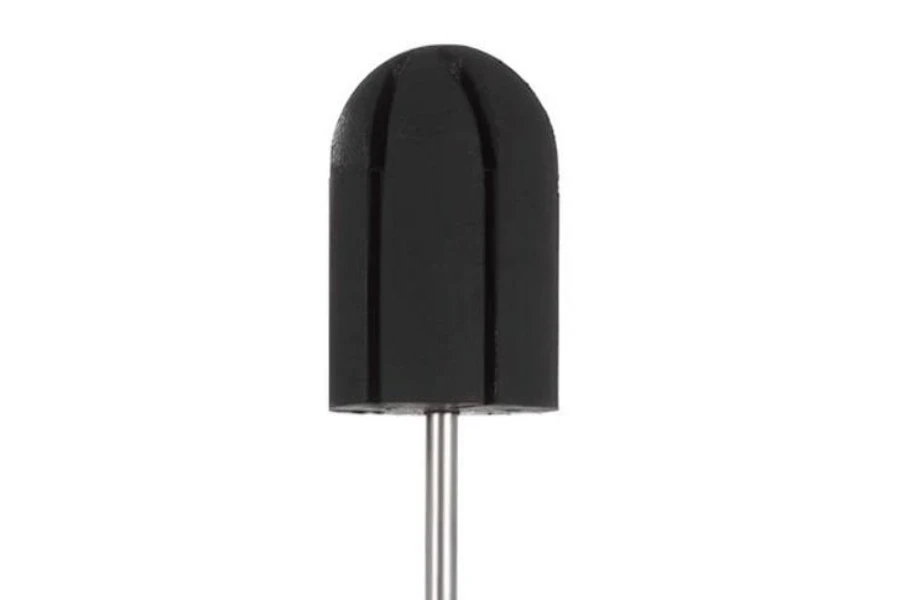
A mandrel bit with a sanding band is the best choice for filing and preparing nails. Mandrel bits always come with sanding bands—manufacturers make the bit from rubber or metal for reusability and the sanding bands from paper or fabric to make them disposable. Businesses can find sanding bands in coarse, medium, and fine grits.
Applications
– Shorten natural nails
– Prepare nail beds to remove oil
– Remove existing gel or polish
– Smoothen acrylic or gel nails
– Smoothen natural nails
Pros
– They can work for various nail enhancement techniques.
– Users can customize the sanding bands and abrasive materials to suit their needs.
– Some mandrel bits have special coatings or designs to reduce heat generation.
– Mandrel bits are relatively easy to clean and sterilize.
Cons
– Beginners may find them difficult to use.
– Despite some bits’ heat reduction designs, they may still overheat due to high-speed or extended use.
– They may weaken or thin the nail plate when used excessively.
Carbide nail drill bits
Carbide nail drill bits are incredibly durable, made from a metal much more robust than steel. They’re popular in nail salons because their designs can handle cutting, filing, and shaping acrylic and artificial nails.
They also have flute-like cuts that help remove products efficiently. Remember, carbide bits are sharp and should only be used on artificial nails, not natural ones.
Applications
– Used by advanced users and professional nail technicians
– Remove acrylic nail products
– Cutting acrylic nails
Pros
– Carbide nail drill bits are highly durable due to their natural hardness. They can handle extended use without dulling or wearing out fast.
– They’re efficient at removing and shaping acrylic and gel nail enhancements.
– Carbide has natural heat resistance.
Cons
– Inexperienced users may cause unnecessary damage with carbide nail drill bits.
– It is not suitable for users with thin or damaged natural nails.
Ceramic nail drill bits
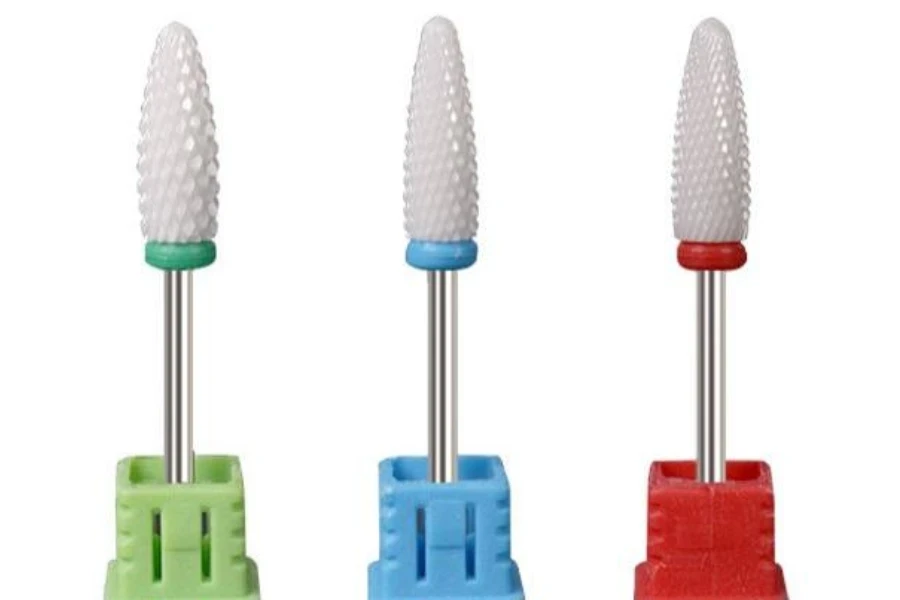
Ceramic nail drill bits are coated with ceramic and have flute-like cuts, much like carbide bits. However, they’re ideal for natural nails and sensitive nail beds because they don’t get hot like carbide bits.
Consumers can use these bits for various manicure tasks, including removing products, exfoliating cuticles, and smoothing nails.
Applications
– Smoothing and buffering nails
– Removing gel and polish
– Exfoliating cuticles
– Shaping nails
Pros
– Ceramic bits are gentle on natural nails, making them suitable for consumers with thin or fragile nails.
– These nail bits are famous for leaving a smooth and polished feeling on natural nails.
– Ceramic bits generate less chatter and vibration during operation.
– They can work on natural nails and various nail enhancement materials.
Cons
– Ceramic bits may not remove materials as quickly as other materials.
– They’re not practical for thicker nail enhancements.
Diamond nail drill bits
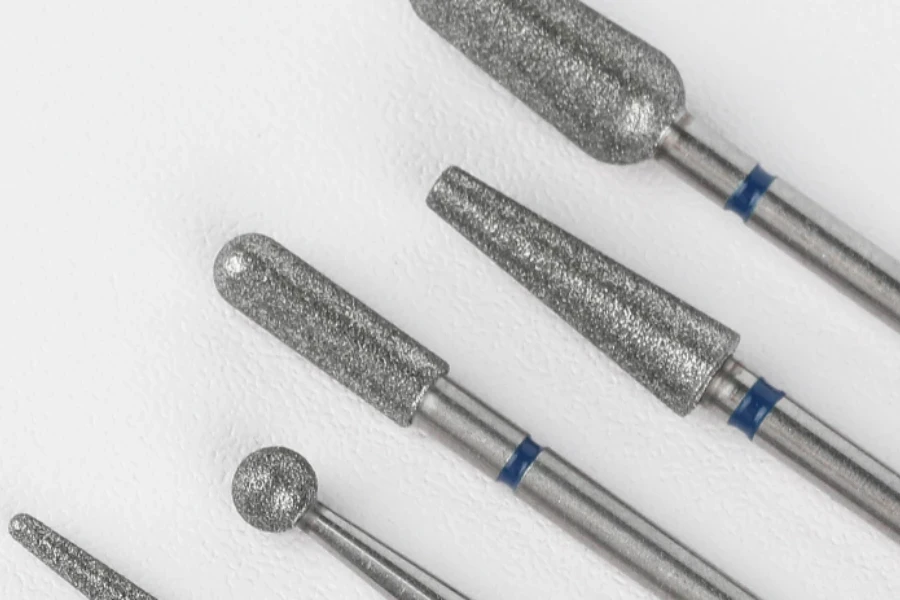
Diamond nail drill bits are versatile and suitable for artificial and natural manicures. Manufacturers make them from natural or synthetic diamond particles, designing the bits to scratch, not shaving off the nails.
Diamond nail drills are particularly effective for precise dead skin removal, natural nail smoothing, and pedicures.
Applications
– Cuticle exfoliation
– Scratching off nail enhancements
– Dead skin removal
– Various pedicure techniques
Pros
– Diamond bits have exceptional durability and long lifespans.
– Consumers can easily remove nail enhancements, including gels, dip powders, and acrylics.
– These bits can handle precise and controlled nail work, making them ideal for creating intricate designs, shaping, and filing.
Cons
– Diamond bits are inefficient at heavy removal tasks, meaning they can’t handle thicker nail enhancements.
– They offer limited shapes and sizes.
Electric nail drill bits
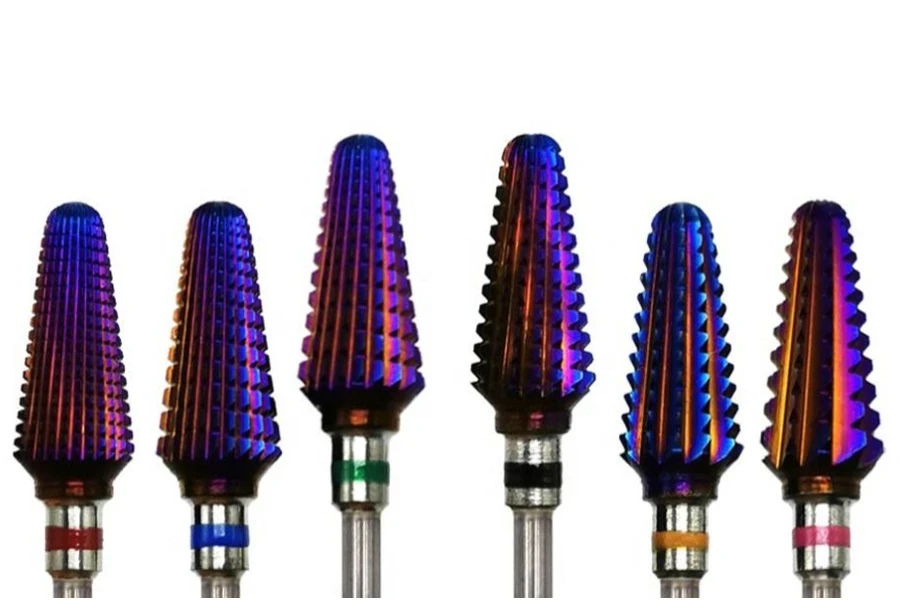
Electric nail drill bits come in various shapes, each serving specific purposes and offering unique benefits. Explore the table below for the different electric nail drill bits and their applications.
| Shape | Description | Application |
| Needle or UNC | It features a slim needle shape with a pointed tip | – Can enter tight spaces- Can perform under-nail cleaning and side walls |
| Cone | It has an extended, slender profile with a cone-shaped tip | – Can prepare sidewalls and cuticles- Can shape toenails- Nail product removal- Under nail cleaning |
| Flame bits | It has a pointed tip with a slim shape | – It is ideal for cleaning around the cuticle- Dead skin removal- Effective for touch-up polishing |
| Barrel | It sports a cylinder shape with a flat, sharp top | – Perfect for nail shortening- Can handle nail surface work- Polish, gel, acrylic, or dip removal- Shaping and cutting nails- Not effective for cuticle |
| Ball top | It features a slim shape with a ball-shaped head | – Exfoliates cuticle edges- Removes dead skin |
| Safety bits | It has a round tip with various sizes | – Can file close to cuticles- Cuticle cleaning and preparation |
Cuticle nail drill bits
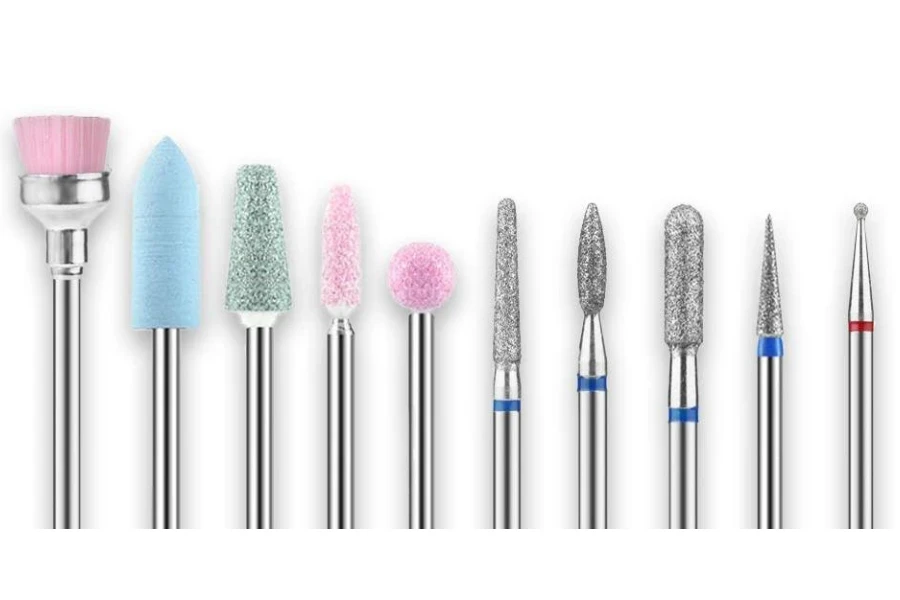
Cuticle drill bits are meant to remove dead skin around the cuticles and sidewalls, preparing the nail for artificial nails or polish. However, using a fine grit bit around the cuticles for natural nails is advisable.
Here are the top types of cuticle nail drill bits and their uses:
| Cuticle bit type | Uses |
| Cone drill bits | They remove excess acrylic or gel around the sidewall and cuticle. |
| Safety bits | They can easily clean cuticles and eliminate dead skin without hurting the nail. |
| Flame drill bits | Their design forms a patch of dead skin around the cuticle for easy removal. |
| Ball top drill bits | They are perfect for polishing and exfoliating the skin surrounding the nails. |
Wrapping up
Nail care routines are gaining popularity as more people realize the advantages of having healthy nails. Beyond their aesthetic appeal, well-maintained nails provide comfort and confidence.
However, many consumers now prefer doing their nail care routines at home instead of going to salons. Consequently, they are increasingly looking for various nail drill bits that meet their needs.
So, this guide offers businesses all the necessary information to prepare for the expected demand increase in 2023.
